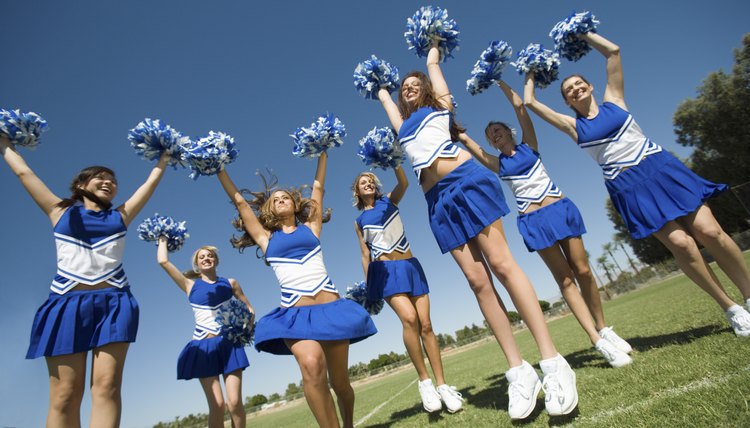Facts About Competitive Cheerleading

Competitive cheerleading is a new sport. According to Varsity.com, the official website for competitive cheerleading, the first official cheerleading competition was in 1980. Since then, the world of competitive cheerleading has exploded to include kids from age 5 to college-age groups. Competitive cheerleading also has a Special Needs Cheer division.
Training
Training for competitive cheerleading is as tough as for any other competitive sport. For example, the cheerleading team of the University of Maryland trains seven days a week. Three times a week they do strength-training. Then they meet four evenings a week for three hours to practice the actual tumbling and stunts. Each squad, from each school, will have their own training schedule.
Competitions
All-Star cheerleading is the name used to refer to cheerleading groups created just for competition and not associated with any school or team. The U.S. All Star Federation is the organization that governs cheerleading competition, sets up regulations regarding safety and competition, and dictates rules of conduct.
Age Levels
Competitive cheerleading is divided into groups according to age. Each group has different levels, according to experience. The minimum number of members per squad is five and the maximum is either 24 or 36, depending on the age group. Cheer divisions include Tiny Cheer, Mini Cheer, Youth Cheer, Junior Cheer and Senior Cheer. Most groups have divisions for male and female cheerleaders, as well as a co-ed division. The youngest group, the Tiny Cheer, is for cheerleaders 5 years or younger.
Status
As of 2013, competitive cheerleading is not considered an official sport. Although there’s been a push for cheerleading’s recognition for years, it hasn’t happened as of 2013. For competitive cheerleading to be considered a championship sport, it must be recognized by the NCAA. Some strides have been made, however. For example, some universities with cheerleading squads are now offering scholarships to cheerleaders.
References
- Feministing: Competitive Cheerleading May Be Recognized as an Official Sport; Maya Rudolph; May 2011
- USASF: All-Star Cheer Divisions
- Varsity.com: History of Competitions
- Currie DW, Fields SK, Patterson MJ, Comstock RD. Cheerleading injuries in United States high schools. Pediatrics. 2016;137(1). doi:10.1542/peds.2015-2447
- Mueller FO, Cantu RC. Catastrophic Sports Injury Research. 27th Annual Report, Fall 1982–Spring 2009. National Center for Catastrophic Sport Injury Research. 2009.
Writer Bio
Tammy Dray has been writing since 1996. She specializes in health, wellness and travel topics and has credits in various publications including Woman's Day, Marie Claire, Adirondack Life and Self. She is also a seasoned independent traveler and a certified personal trainer and nutrition consultant. Dray is pursuing a criminal justice degree at Penn Foster College.
